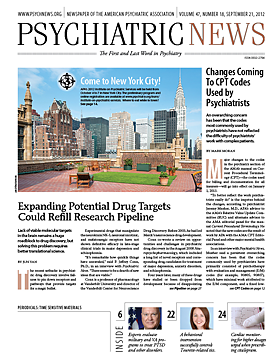The recent setbacks in psychiatric drug discovery involve failures to pin down receptors and pathways that provide targets for a magic bullet.
Experimental drugs that manipulate the neurokinin NK-3, neuronal nicotinic, and melatonergic receptors have not shown definitive efficacy in late-stage clinical trials in major depression and schizophrenia.
“It’s remarkable how quickly things have unraveled,” said P. Jeffrey Conn, Ph.D., in an interview with Psychiatric News. “There seems to be a dearth of new ideas that are viable.”
Conn is a professor of pharmacology at Vanderbilt University and director of the Vanderbilt Center for Neuroscience Drug Discovery. Before 2003, he had led Merck’s neuroscience drug development.
Conn co-wrote a review on opportunities and challenges in psychiatric drug discovery in the August 2008 Neuropsychopharmacology, which included a long list of novel receptors and corresponding drug candidates for treatment of major depression, anxiety disorders, and schizophrenia.
Four years later, many of these drugs have stalled or been dropped from development because of disappointing clinical trial results.
In the pharmaceutical industry, promising molecules are rushed into clinical testing because of the patent clock and long cycles of required clinical trials and regulatory filings. However, what often appears to work in rats may not lead to clear benefits when testing gets around to humans.
“Fifteen to 20 years ago, the research community was too naïve about drug targets,” Conn said. Although the past two decades saw great strides in neuroscientific research, he explained, most of the notable recent failures of once-promising drugs had been in studies initiated for human testing 10 to 15 years ago, when the complexity of psychiatric disorders and their pathologies were not sufficiently appreciated.
Drug-Discovery Model Was Too Simple
Martin Sarter, Ph.D., a professor of psychology and neuroscience at the University of Michigan Department of Psychology, urges researchers to expand their view of drug targets.
“In past drug research, targets were too narrowly defined. A target was solely defined as a receptor or a molecular mechanism related to a disease,” Sarter told Psychiatric News.
For example, receptor X is not properly expressed or is altered by mutation in patients with a certain disorder. Companies would take compounds that bind to the receptor, usually agonists or antagonists, and test them in animal models to see if any molecules would produce effects that suggest efficacy. The compounds that look promising in some models would then be put into human studies.
“This process is often more optimistic than is warranted,” said Sarter.
The optimism might have been reasonable in the boom days of psychiatric drug development a few decades ago, when new antidepressants and atypical antipsychotics seemed to enter the market every year. Unfortunately, those drugs were derived from only a few neurotransmission systems without full understanding of their mechanisms of action. Now these drug classes have been exhausted, and breakthrough new drugs have not emerged.
Sarter shares Conn’s opinion that there was a tendency in pharmaceutical development to throw new molecules into clinical trials without sufficient validation. He argued that to achieve predictable success, the drug discovery process must require an investment of time and resources in mapping neurological systems and psychobiology. In other words, we must understand how manipulating molecular targets can alter specific neurocircuits and what behaviors correspond to these neurocircuits.
“Our focus has primarily been on molecular targets,” Sarter commented. “Between the molecular manipulation and a collection of behavioral effects is a black box. Research on what is in this black box has been largely ignored for a long time.”
Molecular Targets Need Clinical Validation
To achieve a rational approach to designing treatments, Sarter believes that targets should be redefined to include neurocircuits and clinical or behavioral deficits and their connections to brain chemistry.
It will be an expensive and time-consuming endeavor, he admitted, but without this research the cost of failures will mount ever higher.
A better understanding of the entire picture, from molecules to behaviors, can help researchers interpret failed studies. When a molecule fails to cause changes in behavior or mood, “we can peek into the black box and understand why it does not work and then devise ways to get around it,” Sarter said. Otherwise, the risk of repeating failures is high.
Conn emphasized the importance of connecting clinical evidence with laboratory findings. In his opinion, animal models for neuropsychiatric disorders are not yet mature enough to reliably predict clinical effects.
The field of neuropharmacology has made substantial advances in recent years, Conn noted. Researchers can measure the binding profiles of a drug candidate in the brain, and “we now have solid knowledge about how to design drugs that can distribute to the intended places in the body, such as passing the blood-brain barrier,” he said.
Alan Schatzberg, M.D., an APA past president and co-editor of the American Psychiatric Publishing Textbook of Psychopharmacology, Fourth Edition, agreed that the medical community today knows a great deal more about the neurochemical systems as well as specific circuits in the brain.
“It is time to use new approaches to developing agents that can target and affect these biological systems or circuits and then to look for clinical entities where such effects may be important,” Schatzberg told Psychiatric News.
To achieve this goal, however, would require changes in how these clinical entities are viewed. For example, “if we had a drug for working memory or for stress-responsiveness reduction that cuts across diagnoses, how would we assess a drug for the FDA, which currently requires that drugs be assessed on the basis of discrete diagnoses?”
Schatzberg was one of the leading participants in the “Pipeline Summit” on new drug development for psychiatric disorders held earlier this year at APA headquarters (Psychiatric News, April 6).
“We’re making tremendous progress, but I do think the cost and challenges are very great,” Conn summed up. “If the community can sustain the necessary level of funding [to continue the research], we can be much more productive in the next 10 years.”

